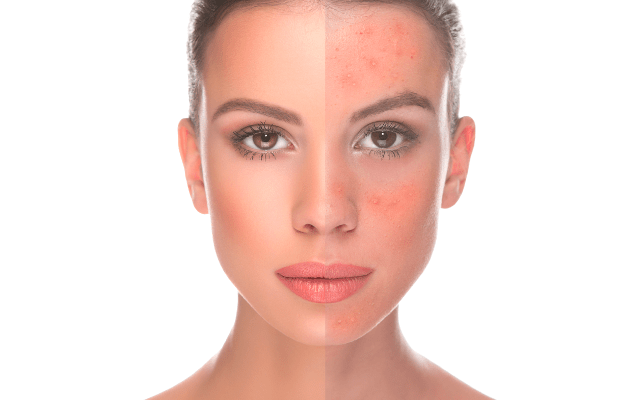
Rosacea is usually associated as a noticeable redness or blushing on a person’s face. This is a common skin disease that over 14 million people suffer from. Rosacea may first appear as a tendency to blush more easily than others. Eventually, this redness may spread to other areas of a person’s body including their neck, chest, back, or ears. Unfortunately, this redness may eventually stay – even when someone isn’t blushing.
Rosacea is not limited to just blushing or a redness, as it can also cause other symptoms. A person’s symptoms will determine which type of rosacea they have.
Below are the four types of rosacea and the symptoms that are associated with each type:
Erythematotelangiectatic Rosacea: Flushing, redness, and visible tiny blood vessels.
Papulopustular Rosacea: Acne-like breakouts, swelling, and redness
Phymatous Rosacea: Red skin with thicken and a bumpy texture
Ocular Rosacea: Swollen eyelids, red and irritated eyes
Women are more likely to have rosacea, but men tend to suffer from more severe rosacea symptoms. Common triggers (or items that cause a flare-up of symptoms) for rosacea include hot or spicy food, alcohol, emotional stress, heat, saunas, and smoking. Sun exposure can worsen symptoms, so it is important to always wear sunscreen when you are outdoors. If you suffer from rosacea, you will want to try to reduce your exposure to these triggers, as untreated rosacea will worsen over time. Make sure you always:
- Wear sunscreen
- Use rosacea-friendly skincare products
- Wear green-tinted makeup
- Reduce or eliminate triggers
- Avoid smoking or cigarette smoke
No one knows exactly what causes rosacea, but oftentimes it runs in families. Other risk factors for developing rosacea include having an English, Irish, or Scottish heredity, fair skin, blonde hair and blue eyes, or even being a female between the ages of 30 – 50 years of age. H. pylori, a type of bacteria that normally lives in a person’s stomach, can raise the amount of a hormone in your digestive tract. This can cause a person’s skin to look flushed and aggravate the symptoms of rosacea. Another bacterium that is thought to cause rosacea is bacillus oleronius. This bacterium causes a person’s immune system to overreact, which then creates the acne symptoms of rosacea.
Unfortunately, rosacea is considered an inflammatory condition with no cure. Luckily, there are several treatment options for rosacea including: laser or light-based therapy, prescription creams such as brimonidine gel and metronidazole cream, retinoid, antibiotics, and more. Treatment options depend on each person and they type of rosacea they have. To learn about the treatment options available to you, please call our office and schedule an appointment.
Disclaimer: This blog provides general information and discussion about medical, cosmetic, mohs, and surgical dermatology. The words and other content provided in this blog, and in any linked materials, are not intended and should not be construed as medical advice. If the reader or any other person has a medical concern, he or she should consult with an appropriately-licensed dermatologist or other health care worker.
